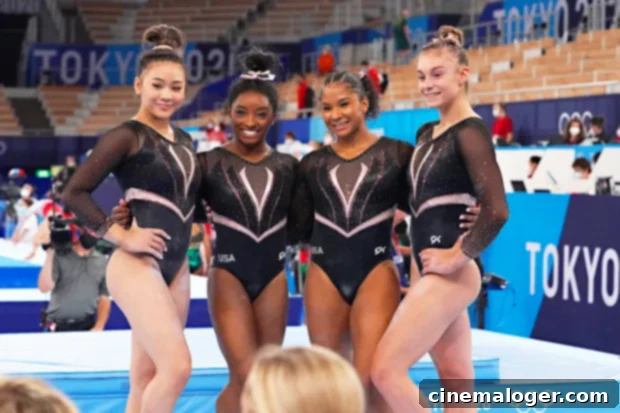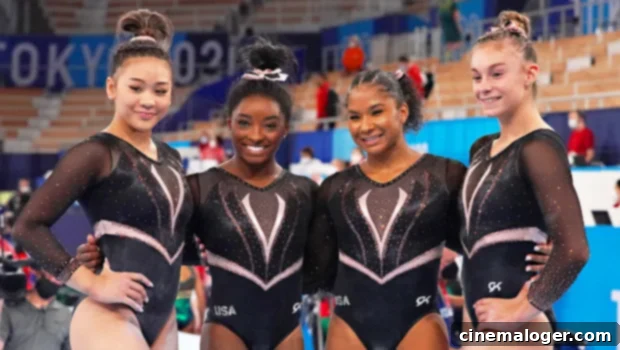The Strategic Absence: Why Simone Biles and Team USA Gymnastics Skipped the Tokyo Olympics Opening Ceremony
The Tokyo 2020 Olympic Games, held under unprecedented circumstances in 2021, kicked off with an opening ceremony that, while memorable, notably lacked the full presence of some of the most anticipated athletes. Among those conspicuously absent from the iconic Parade of Nations were superstar gymnast Simone Biles, 24, and the rest of the highly acclaimed U.S. women’s gymnastics team. Their absence sparked widespread curiosity and questions among fans and media alike. However, the decision was far from arbitrary, stemming from a confluence of crucial factors, ranging from intense athletic preparation to stringent COVID-19 safety protocols and strategic considerations for peak performance.
Prioritizing Preparation Over Pageantry
For elite athletes, particularly gymnasts whose sport demands an extraordinary level of precision, strength, and mental fortitude, the days leading up to competition are sacred. The U.S.A. Gymnastics spokesperson confirmed to The New York Times that the team felt it was more important to be “focused on preparation” rather than participate in the elaborate opening ceremony. This sentiment was echoed by Simone Biles herself during a brief Q&A session with fans on her Instagram story, where she outlined a combination of reasons for their non-participation.
The opening ceremony, while a dazzling spectacle and a cherished Olympic tradition, can be a physically demanding event for participants. It involves hours of standing, waiting, and marching in often warm and humid conditions, which was certainly the case in Tokyo. For gymnasts, whose bodies are finely tuned instruments needing optimal rest and recovery, engaging in such a prolonged activity just before the start of competition could potentially disrupt their physical and mental readiness. The risk of fatigue, minor aches, or even accidental injury from prolonged standing or jostling in a crowd is a serious consideration that could jeopardize years of dedicated training.
Furthermore, the focus required for an Olympic competition is immense. Diverting attention to ceremonial duties, even celebratory ones, might detract from the laser-sharp concentration needed to execute complex routines flawlessly. For a team with high expectations and aspirations for multiple medals, every decision, no matter how small, is weighed against its potential impact on performance. The choice to skip the ceremony underscored a pragmatic approach, emphasizing competitive advantage and athlete welfare above all else.
View this post on InstagramA post shared by Simone Biles (@simonebiles)
Celebrating Their Own Way: Team USA’s Private Moment
Despite missing the grand spectacle, the gymnasts found their own way to commemorate the beginning of the Games. The gold medalist, Simone Biles, took to her Instagram to share photos of herself and her teammates celebrating the start of the Olympics together. “LET THE GAMES BEGIN,” she enthusiastically captioned the post. One photo captured her leaping joyfully with teammate MyKayla Skinner, 24, both proudly sporting their Team USA jackets. Another picture showcased a group shot of the entire gymnast team posing united in their official attire.
During her Instagram Q&A, which covered various questions about the Games and Tokyo, many fans inquired about the team’s absence from the ceremony. Responding to a question about whether the team attended, Simone replied, “We did our own little walk outside where we are staying.” This simple statement highlighted their adaptability and determination to experience the Olympic spirit, even if it meant creating their own intimate version of the traditional parade. This private celebration allowed them to acknowledge the momentous occasion without compromising their preparation or safety.
The Overriding Shadow of COVID-19
Perhaps the most critical and unavoidable reason for their absence was the pervasive threat of the COVID-19 pandemic. The Tokyo Olympics were unique, operating under exceptionally strict health and safety protocols, creating a “bubble” environment designed to minimize transmission risks. However, despite these measures, a handful of Olympic athletes had tested positive for coronavirus shortly after arriving in Tokyo, casting a constant shadow of concern over the Games.
A particularly concerning incident involved Kara Eaker, 18, an alternate for the Team USA gymnastics squad, who tested positive for COVID-19. According to NBC, Kara was promptly transferred to a hotel for isolation and quarantine. This development sent a clear message to the team: even with rigorous protocols, the virus was a real and present danger. Following Eaker’s positive test, the gymnastics team made a unanimous decision to prioritize their health and safety by staying in a hotel rather than the larger, more communal Olympic Village. The Village, while offering a quintessential Olympic experience, also presented a higher risk of exposure due to its dense population of athletes and staff from around the world.
Coach Cecile Landi elaborated on this decision via Twitter, stating, “It was also a decision that we all made together, we know it isn’t ideal for the Olympic experience but nothing is ideal during a pandemic. We feel like we can control the athletes and our safety better in a hotel setting!” This quote perfectly encapsulates the pragmatic approach taken by the team, acknowledging the compromise on the “ideal Olympic experience” but prioritizing the health and well-being of the athletes above all else. The controlled environment of a hotel offered greater peace of mind and significantly reduced the potential for close contact with asymptomatic carriers, which was paramount given the close-contact nature of gymnastics training and competition.

Strategic Planning: The Performance Edge
Beyond the immediate concerns of COVID-19, the decision to skip the opening ceremony also appears to have been a highly strategic one aimed at maximizing competitive performance. Simone Biles herself highlighted the logistical challenges of the ceremony for gymnasts. “The amount of standing is crazy. USA is usually at the end, because alphabetical,” she explained in her Instagram Story. The Parade of Nations is structured alphabetically by host country language, meaning the United States typically enters the stadium much later, requiring athletes to stand and wait for extended periods before their turn.
This prolonged standing, coupled with the fact that gymnastics competitions were scheduled to begin the very next day, made participation in the ceremony a high-risk proposition for performance. As Simone succinctly put it, “So it wouldn’t be smart.” For gymnasts, whose muscles and joints are under immense strain during routines, even minor fatigue or soreness from prolonged standing could impact their execution and overall scores. Maintaining peak physical condition and mental freshness is non-negotiable for Olympic success.
Furthermore, Simone Biles noted that she doesn’t believe the U.S. women’s gymnastics team has ever attended the Olympic opening ceremony. While a definitive historical record is difficult to ascertain, this statement suggests a long-standing tradition or understanding within the team that prioritizing early competition readiness often outweighs ceremonial participation. Many sports, particularly those with early competition schedules or high physical demands, often see athletes or entire teams opt out of the opening ceremony to ensure they are in optimal condition for their events. This practice is not uncommon and reflects a professional dedication to the competitive aspect of the Games.
A Holistic Decision for Athlete Well-being and Performance
In conclusion, the absence of Simone Biles and the Team USA Gymnastics squad from the Tokyo Olympics opening ceremony was a carefully considered decision driven by a complex interplay of factors. It wasn’t a rejection of the Olympic spirit, but rather a strategic choice rooted in safeguarding athlete health, minimizing COVID-19 risks, and optimizing for peak competitive performance. The unique challenges of a pandemic-era Olympics amplified the necessity for such pragmatic decisions, illustrating a shift towards prioritizing athlete welfare and readiness above all else.
By opting for a controlled hotel environment and focusing intensely on their training, the team demonstrated a profound understanding of what it takes to perform at the highest level on the world’s biggest stage. Their private celebration, while different from the global spectacle, underscored their unity and excitement for the Games, proving that the Olympic spirit can thrive even away from the main stadium lights, as long as the athletes are prepared, healthy, and ready to compete.
